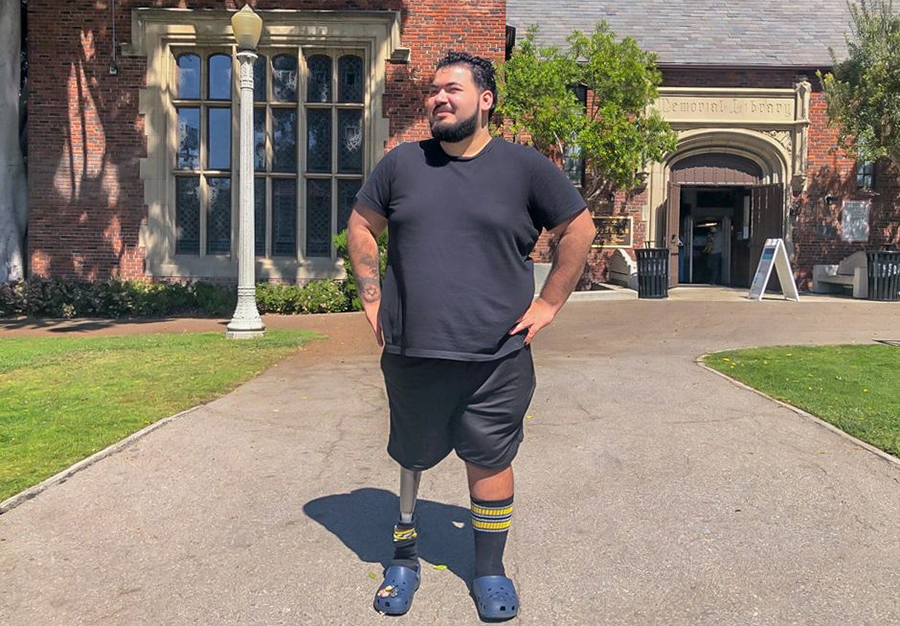10.03.2022
By uscbknpt
Back on His Feet

Robert Johnson recently underwent osseointegrative surgery after experiencing a leg amputation. After surgery, he was treated by USC faculty member Lisa Fukuzato, who helped him get back to the life he left behind. Next goal for Johnson: to run!
BY STEPHANIE CORRAL
ROBERT JOHNSON WILL NEVER FORGET THE FIRST TIME he held his 2-year-old daughter Leia while standing upright.
Three months before she was born in January 2020, Johnson had his right leg amputated above the knee to prevent the spread of bone cancer. In 2021, the 28-year-old underwent osseointegration, a surgical procedure that embeds a prosthetic into the bone of an individual who has experienced an amputation.
For the first-time father, dropping his daughter was his biggest fear.
But one day, she ran toward him unexpectedly while they were playing.
“It was kind of scary,” Johnson recalls. “You know how in those movies where the child runs, and you pick the baby up, throw her up in the air, and then grab her? That’s what I did. I risked it. I thought, ‘I think I can do it’ and I was able to do it.”
Such a daring move would have been unthinkable had it not been for the physical therapy he has received through USC’s Division of Biokinesiology and Physical Therapy, which has provided Johnson with the training, strength and confidence to adjust to post-osseointegration life.
Bucking the traditional prosthesis
Choosing amputation was not an easy decision for Johnson, who was looking forward to becoming a father.
“I wanted to be able to run and be able to do the same activities that I would do,” Johnson says. “But cancer is scarier to me than an amputation because cancer is cancer.”
Unfortunately, the traditional prosthetic leg that he had been fitted with made walking difficult.
“It would fall off and it was very uncomfortable,” says Johnson, who once fell inside a Target store because of his prosthetic.
Frustrated by his lack of stability, Johnson came across osseointegration through a Google search.
Unlike the cuplike socket of a traditional prosthetic, osseointegration provides amputees with stability, greater range of motion and a more natural gait.
After undergoing the two-part procedure with Dr. Lawrence Menendez — an orthopedic oncologist at Keck Medicine of USC, Johnson is overjoyed with the results.
“I know how the floor feels again,” Johnson says. “It was incredible because I never thought I would be able to feel those kinds of sensations all over again. It was totally different and unique. It was everything I wanted from a prosthetic and more.”
Holding his daughter
In September 2021, Johnson started seeing Assistant Professor of Clinical Physical Therapy Lisa Fukuzato for physical therapy.
Fukuzato says that a clinician should be closely monitoring patients for pain, infection and tolerance with progression through the rehabilitation process.
“A graded and carefully guided rehabilitation program is necessary to prevent overload, and patient education and adherence to recommendations is critical,” Fukuzato says.
To protect the patient and facilitate the healing process, patients must complete a specific loading program before being cleared to use their full prosthesis.
“It’s so exciting when they are finally able to walk with their prosthesis,” Fukuzato says. “It’s a highly rewarding aspect of my career to be a part of their recovery journey.”
Under Fukuzato’s careful guidance, Johnson has been able to gain muscle in his thighs, glutes and core, which has given him the ability to lift semi-heavy objects. More importantly, he can finally hold his daughter.
“She’s very good at motivating me to do that extra push to get there,” Johnson says.
The amount of time that physical therapists get to spend with their patients is what drew Fukuzato to the profession.
“I love the personal connection that comes with treating patients,” Fukuzato says.
First he walks, then he runs
Most recently, Johnson’s physical therapy sessions have focused on improving balance and exercises to help him walk up and down stairs.
Highly motivated by his progress, he hopes to be able to run someday with the aid of a running blade prosthetic.
“Running has been my goal ever since I lost my leg,” Johnson says.
Helping patients reach their personal mobility goals is what ultimately drives Fukuzato.
“I hope that they reach the level of mobility they are working so hard to achieve,” Fukuzato says.

